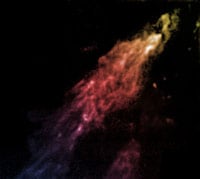Original URL: https://www.theregister.com/2008/01/14/smiths_cloud/
Giant hydrogen cloud menaces Milky Way
Coming (relatively) soon to a galaxy near you
Posted in Science, 14th January 2008 12:49 GMT
A giant cloud of hydrogen gas dubbed "Smith's Cloud" which contains enough gas to create a million stars like our own sun is on a collision course with the Milky Way, the National Radio Astronomy Observatory (NRAO) has announced.
 There is, however, no need to alert Bruce Willis quite yet: the cloud is currently 8,000 light years from our galaxy, and at its current speed of around 150 miles per second, won't make contact for around 40 million years.
There is, however, no need to alert Bruce Willis quite yet: the cloud is currently 8,000 light years from our galaxy, and at its current speed of around 150 miles per second, won't make contact for around 40 million years.
When it does, though, scientists expect some fireworks. Felix J Lockman of the National Radio Astronomy Observatory (NRAO), the head of the team of astronomers who used the National Science Foundation's Robert C Byrd Green Bank Telescope (GBT) to study the cloud, explained: "This is most likely a gas cloud left over from the formation of the Milky Way or gas stripped from a neighbor galaxy. When it hits, it could set off a tremendous burst of star formation. Many of those stars will be very massive, rushing through their lives quickly and exploding as supernovae. Over a few million years, it'll look like a celestial New Year's celebration, with huge firecrackers going off in that region of the galaxy."
Smith's Cloud is certainly big enough to promise an impressive interaction with the Milky Way. It's 11,000 light years long (15 degrees in the sky, or 30 times the width of the full moon), and 2,500 light-years wide. Lockman added: "If you could see this cloud with your eyes, it would be a very impressive sight in the night sky. From tip to tail it would cover almost as much sky as the Orion constellation. But as far as we know it is made entirely of gas - no one has found a single star in it."
"Its shape, somewhat similar to that of a comet, indicates that it's already hitting gas in our Galaxy's outskirts," Lockman went on. "It is also feeling a tidal force from the gravity of the Milky Way and may be in the process of being torn apart. Our Galaxy will get a rain of gas from this cloud, then in about 20 to 40 million years, the cloud's core will smash into the Milky Way's plane."
In case you're worried for future generations, the impact will be some way from our own solar system. The NRAO has an artist's conception of Smith's Cloud approaching here. ®